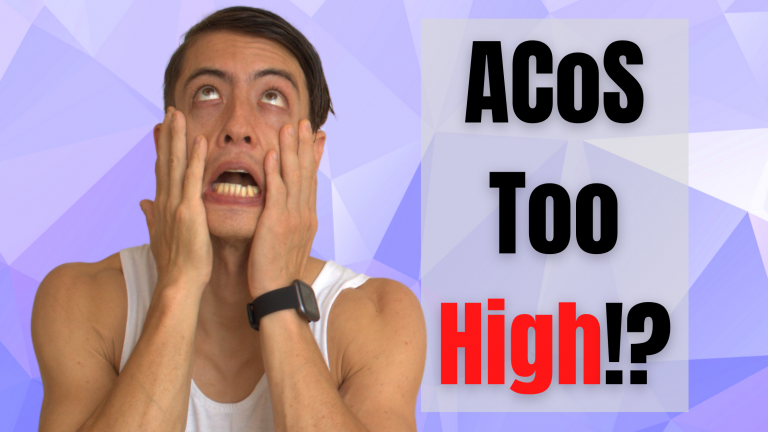What Is ACoS Amazon?
ACoS Amazon Meaning
Amazon Sponsored Products ACoS (“advertising cost of sales”) is an important metric for measuring the effectiveness of your Amazon PPC advertising campaign.
Each Sponsored Product campaign’s ACoS can be found by logging into Seller Central and navigating to Campaign Manager.

What Does ACoS Mean in Amazon Advertising?
Your ACoS is the best way to determine the effectiveness of your advertising campaigns and is given as a percentage of your revenue.
In other words, it’s a ratio of how much you spend on advertising per dollar you make of revenue.
Therefore, if you have an ACoS of 25%, it means you spent $0.25 per each dollar you made in revenue.
Amazon ACoS vs. Amazon ROAS
Amazon ACoS tells you how much you spent per dollar made, whereas ROAS (return on ad spend) tells you how much you made for each dollar spent.
So ROAS is the inverse of ACoS, and both are great ways to measure the efficacy of campaigns.
How to Calculate ACoS Amazon
How is ACoS Determined in Amazon?
Your ACoS is determined by this formula:
ACoS = Total Ad Spend / Total Sales
Amazon ACoS Example
Let’s say your sales totaled $1000, and you spent $150 on PPC advertising.
Your ACoS would be calculated as follows:
150 / 1000 = 15%
This means you spent 15 cents for every dollar you got back in revenue.
To calculate ROAS, you simply take the inverse.
1000 / 150 = 6.67
This means every dollar you put into advertising yielded $6.67 back.
How to Work Out My Ideal Amazon ACoS
Generally speaking, a healthy amazon ACoS will be below your breakeven profit margin. This is the threshold at which you are neither making nor losing money.
When you are first launching a PPC campaign, it is likely your ACoS will be high because you will need to optimize your keywords and bids. However, in order to optimize your campaigns, you will need to know your breakeven profit margin.
Amazon ACoS Breakeven Formula
First, you need to know your profit margins. This is calculated by subtracting the cost of goods (manufacturing costs, shipping, and any Amazon fees) from the list price.
Profit margin = List price – cost of goods (manufacturing cost, shipping, Amazon fees, etc.)
Let’s say my product sells for $20, costs $6 to manufacture, $1.5 to ship, and Amazon charges $12 in fees (referral and FBA fee), the calculation would look like this:
$20 – $5 – $1.5 – $10 = $3.5
$3.5 / $20 = 17.5%
Now you know your profit margin is 17.5%. This number is also your breakeven ACoS, which means you will have to lower your ACoS to under 17.5% in order to be profitable.
ACoS Amazon Calculator
Don’t want to bother doing manual calculations? Don’t worry, we got you. Check out this free Amazon ACoS calculator here.
How to Hit Your Target ACoS
TACoS stands for “target ACoS”. This is simply your ideal ACoS based on whatever profit margin you want for your product.
For example, let’s say your ACoS is 29% and your margin is 5%. Let’s say your long term goal is to have a margin of 15%. Here is the formula:
TACoS = ACoS – (ACoS – desired margin – current margin)
In the example above, we can calculate the TACoS as follows:
29% – (29% – 15% – 5%) = 29% – 9% = 20%
Now we know that in this example, you’d have to lower your ACoS to 20% to achieve your desired 15% profit margin.

What Is a Good ACoS on Amazon?
So you might be wondering: what is a good ACoS for Amazon PPC?
Here’s the thing… you might think that a low ACoS is always better.
But there’s actually no objectively good or bad ACoS.
There will be times when you want a high ACoS, and there will also be times when you want a low ACoS.
It all comes down to your goals:
- Goal #1 – Maximizing Sales: When you’re first launching a product, you may be focused on generating as many sales as you can. This means your ACoS will be higher so you can run aggressive PPC campaigns to build up sales momentum. In this case, your ACoS may be at breakeven or even a little higher.
- Goal #2 – Maximizing Impressions: Maximizing impressions makes sense when you want to increase brand awareness. In this case you might focus on getting as many impressions as possible while hovering at breakeven.
- Goal #3 – Maximizing Profit: This should be everyone’s long term goal once you’ve passed your launch phase. Gradually reduce your ACoS down to your TACoS in order to achieve a certain profit margin.
What is the Average ACOS on Amazon?
The average ACoS on Amazon is around 27.59%, according to this article.
This doesn’t necessarily mean that number is good for you, though. It may be too high or too low depending on your goals.
What’s more is this number doesn’t take into account the multitude of variables that affect ACoS. Different industries will have varying ACoS, and it will fluctuate up and down depending on the time of the year, with the winter months showing an average increase of up to 5%.
In short, it’s not helpful at all to compare your ACoS to the average ACoS for all Amazon sellers. Your situation will be different from someone else.
Amazon ACoS by Industry
The industry you are selling in will affect your ACoS.
Brand-dominated categories require a more elaborate marketing strategy. For example, perfumery is dominated with traditional brands who mostly distribute their products to retailers. Retailers usually have an EBIT (earnings before interest and taxes) of ~7%, so their marketing budget is quite low.
Plus, consumers are searching for specific brands and brand-related keywords, and so these keywords usually have a very high conversion rate. With a limited budget and high conversion rate, the ACoS for these types of categories is very low—around 7%.
By contrast, private label categories are far less brand-dominated. Consider garlic presses, whose traditional brand market share is relatively low, and the net margin of direct-to-consumer sellers is significantly higher. This means that everyone is competing for the attention of their customers, who don’t really care about the brand so long as the product does what it says. Because of this, click prices are higher and so ACoS will be higher as well, often as high as 25% or more.
4 Tips on How to Lower Amazon ACoS
Lowering your ACoS can be quite tricky, as there are many different factors that influence it. There isn’t a cookie-cutter approach.
When optimizing ACoS, we recommend making one change at a time. That way, you will know exactly what methods are working and which ones are not. If you make more than one change at a time, you will not be able to know how effective each method is.
Tip 1: Use the Right Keywords
If you want to reach relevant leads who will be more likely to convert, choosing the right keywords is crucial. The right keywords will help you find more customers.
So, how do you find the right keywords?
There are two ways you can find the right keywords:
- Auto-Campaigns: When running a PPC campaign, you will always want to run an Auto-Campaign alongside your Manual ones. This is because Auto-Campaigns leverage Amazon’s massive database of data to help find potential keywords that you may not have otherwise been able to find. Make sure to check your Auto-Campaigns regularly to see if it picks up any good keywords.
- Keyword Research Software: There are plenty of softwares out there that can help you conduct keyword research, such as Helium 10 (paid) or Sonar (free).
Once you have your keywords, you will want to add them into your listing. This is so that Amazon knows to index your listing for a particular keyword.
Tip 2: Optimizing Listing Content
As you drive customers to your listing, you want to make sure that you are providing them with the relevant information they need to make a purchase. If something on the listing isn’t optimized, they will click off and look elsewhere. That’s why having great photos and copywriting is so important.
The better the content is, the more conversions you will get, and the less people will click off your listing after they click your ad.
Check out our article here for more information about listing optimization.
Tip 3: Optimizing Titles
Your title is one of the first things your leads will see when they look at your sponsored product ad. If you want more leads into your listing, you need to optimize your title to get more people to click on it.
The title should focus on keywords as well as the relevant information surrounding those keywords that your customers want to know. Ask yourself, if someone is searching for your product, what information would they like to know right away?
For example, say you’re selling paper cups. Information about colour, quantity, and sizing would be important. This information would cause more people to gravitate towards your ad if that is what they are looking for, and would help repel people away from clicking on your ad (which would cost you money) who aren’t looking for what you’re selling.
When you create a relevant ad, your title will help you capture more relevant leads. Check our article here for more information about optimizing product titles.
Tip 4: Hone In On the Optimal Bid
The biggest mistake sellers make is setting the wrong bid amount. It could be either too high or too low. If you want to get the best bang for buck and lower your ACoS, you need to hone in on the right bid amount.
Thankfully, there is a really simple formula to help you determine the optimal bid:
(average order value of KW x conversion rate of KW) / (1/TACoS) = Estimated bid amount
This doesn’t mean that this is the best bid amount. It’s just a ballpark estimate to help you find the optimal bid amount quickly.
Conclusion
Your ACoS is the most important metric for running a successful Amazon PPC ad campaign.
It will tell you how effective your campaign is by showing you how much money you get from your ad for every dollar you put in. It doesn’t get much simpler than that.
When optimizing your ACoS, the fastest way to see results is to focus on listing optimization. Having stunning photos and compelling copywriting is the bait that will get your leads to bite and buy your product instead of clicking off.
Check out Kenji ROI’s wide selection of listing optimization services here.



